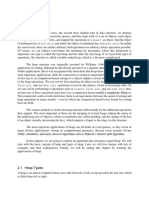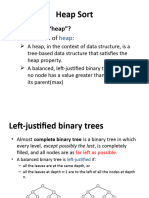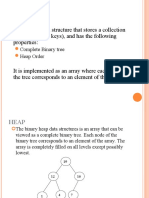0% found this document useful (0 votes)
3 views29 pagesAda Module3
A heap is a nearly complete binary tree that can be efficiently implemented using an array, characterized by the shape property and parental dominance. There are two main methods for constructing a heap: bottom-up and top-down, and heaps can be used for sorting through a two-stage heap sort algorithm. The time efficiency of heapsort is Θ(n log n) in both worst and average cases, making it competitive with mergesort but generally slower than quicksort.
Uploaded by
bhveanCopyright
© © All Rights Reserved
We take content rights seriously. If you suspect this is your content, claim it here.
Available Formats
Download as PDF, TXT or read online on Scribd
0% found this document useful (0 votes)
3 views29 pagesAda Module3
A heap is a nearly complete binary tree that can be efficiently implemented using an array, characterized by the shape property and parental dominance. There are two main methods for constructing a heap: bottom-up and top-down, and heaps can be used for sorting through a two-stage heap sort algorithm. The time efficiency of heapsort is Θ(n log n) in both worst and average cases, making it competitive with mergesort but generally slower than quicksort.
Uploaded by
bhveanCopyright
© © All Rights Reserved
We take content rights seriously. If you suspect this is your content, claim it here.
Available Formats
Download as PDF, TXT or read online on Scribd
/ 29




















































































